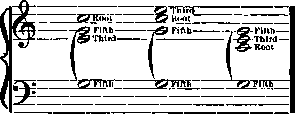Harmony Book For Beginners - online book
Scales, Intervals, Common Chords, Dominant Seventh Chord and Melody Making.
| Share page | Visit Us On FB |
|
66 |
OREM'S HARMONY BOOK |
||
|
In working out the foregoing, reason it out thus : In the Scale of C the Tonic is C; hence the Tonic Chord must be C-E-G, and the First Inversion will require E (the Third of this Chord) in the Bass. In the Scale of C the Dominant is G; hence the Dominant Chord must be G-B-D, and the Octave Position requires G in the Bass and G at the Top, and so on.
At this stage the student should practice diligently the naming and writing of Common Chords according to the Degree names of the Scale. |
|||
|
|
|||
|
When the Fifth of a Chord is placed in the Bass, the Chord is said to be in its Second Inversion. In writing the Second Inversion of any Chord the Fifth of the Chord ie the best member to Double.
Here is the Second Inversion of the C Major Chord written in three ways, the Fifth being Doubled in each case : |
|||
 |
|||
|
Play these over many times and endeavor to fix the effect firmly in the mind. Note the total difference between the Second Inversion and the First Inversion and bow both of these differ from the Positions. Once again let us recapitulate : |
|||
|
|
|||
 |
|||
|
See what may be done with a single Common Chord. What may be done with one may be done with all.
A Chord in its Second Inversion seems invariably to give the impression of something to follow.
Too much attention cannot be paid to the Second Inversion. Beginners in musical construction, and practical writers also, for that matter, frequently fail to appreciate its significance and true usefulness.
As an exercise let the student write out (each in three ways) the Second Inversions of the Tonic Chords of the Major Scales of C, G, D, A, E, B, Gb, Dfc Ab, Eb, B>, F, giving the proper Signature for each Scale. |
|||